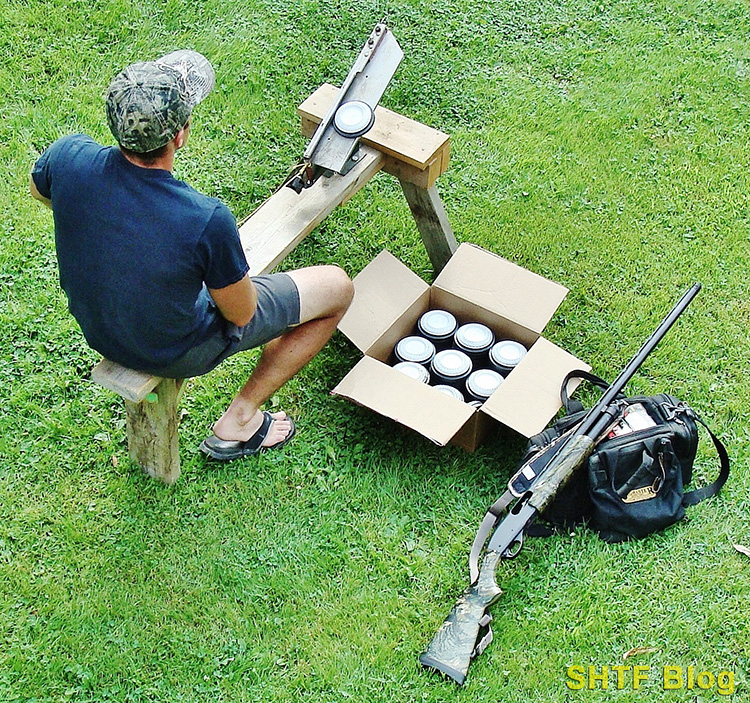
Shotgun shot sizes, gauges, and drams can be confusing to even experienced shooters. It doesn’t need to be. In this article I’ll break down the basics to give you, the shotgun shooter, a better understanding of your shotgun and its many options.
If you want even more detail than what’s provided in this article, consider my book on shotguns: Shotguns, A Comprehensive Guide. I pulled some of the content from that book into this article, but the book contains lot more information on shotgun shells, gauges, optics, etc.
- Markwith, Steve (Author)
- English (Publication Language)
- 190 Pages - 11/27/2014 (Publication Date) - PrepperPress.com (Publisher)
Bare Shelf Background
Bare ammo shelves are an increasingly common sight. But, for those of us who shoot, this scene is nothing new. Case in point: last summer, the claybird crew I shot with struggled to maintain a weekly schedule. We had few troubles sourcing clay pigeons, but shotgun shells were scarce.
Any we tracked down were also ridiculously expensive. I finally dusted off my reloading press and dragged out a bag of 12 Gauge Winchester AA hulls. Before long I had a supply of factory-equivalent skeet loads. Others began stalking shelves in hopes of finding something similar. One member of our group finally found a case of off-brand 12-gauge shells, but one unexpected dividend was their snappy recoil.
When I inquired about the load, his answer was confined to the shot-charge, an ounce and an eighth of #7 ½. Dram-equivalent? That question elicited a shrug. Turned out, “drams” were a mystery for everyone present despite many years of experience. Then again, since we were shooting what we could find, that information may have been moot.
However, “drams” do translate to velocity – with a direct bearing on recoil. Say you’re starting a new shooter on informally tossed claybirds. No sense pummeling anyone, let alone a smaller-statured beginner. Beyond a sore face and bruised shoulder, the likely outcome will be an incurable flinch.
Ammo Box Labeling
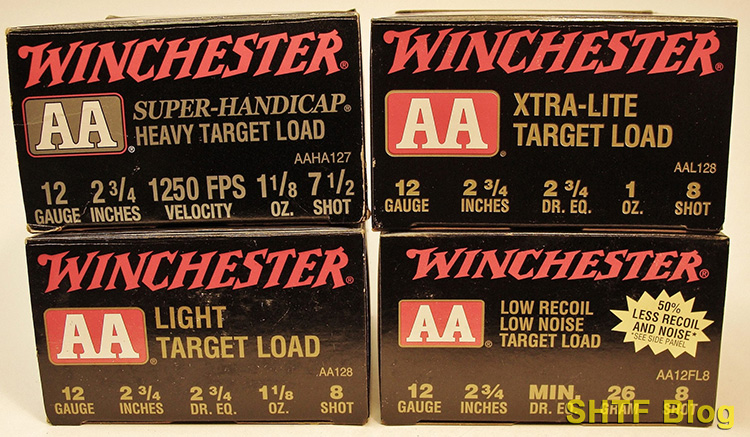
Fortunately, these problems can be avoided – if we can decipher the information on a shell-box. So, check out the four 12 Gauge shell boxes shown in the above photo, starting with the one to the upper right.
It’s a mild Winchester AA X-TRA LITE Target Load suitable for regulation skeet targets, or others engaged inside 35 yards.
- 12 Ga. Indicates the “gauge” of the shell; a 12 gauge.
- 2 ¾ INCHES Indicates the length of the shell.
- 2 ¾ Dr. Eq. Indicates the powder charge; 2 ¾-dram-equivalent.
- 1 oz. Indicates the shell’s shot load in ounces.
- 8 SHOT Indicates the size of the shot; #8 pellets.
Next come the details. Still a mystery for some, the “gauge” system is a reasonable starting point.
Gauges
A traditional shotgun uses a smooth-bore barrel designed to fire multiple projectiles. As such, there’s no real need for a precise caliber governing the fit of a bullet to a bore. Still, some degree of standardization is necessary. Thus, the gauge-designation, which dates to before the industrial revolution. For a longer explanation of gauges, see my article Shotgun Gauges Explained.
Gauge Progression
A 12 Ga. is bigger than a 20 Ga., which might seem backwards. It’s an old British system that “gauges” a shotgun barrel. The gauge itself is determined by the number of lead balls that will squeak through the shotgun’s barrel to equal one pound. If we nudged a lead ball through a 16 gauge barrel, we’d discover each one weighed an ounce. If we set our scale to balance out at one pound, we’d count sixteen.
If a larger barrel was gauged with this system, it would take fewer balls to hit the 1-pound mark. Examining a 12 Ga., each ball would weigh 1 1/8 ounces, and it would only take 12 of them to equal a pound.
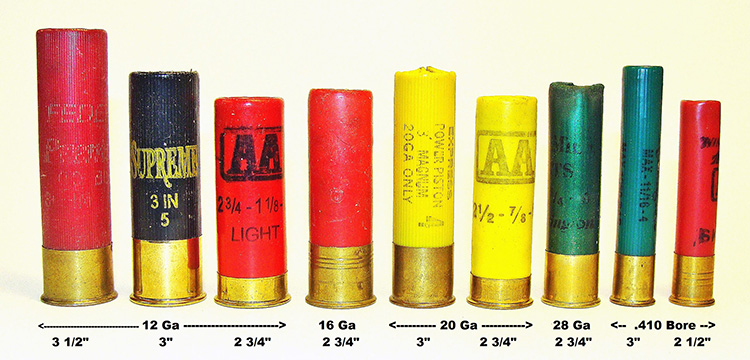
On the other hand, the smaller 20 gauge would require more lead balls to reach the pound mark. Because they’re smaller, each of the 20’s lead spheres would only weigh 7/8 ounce.
A 28 Gauge is even smaller (and many are a joy to carry). An anomaly is the little .410 bore, which isn’t a gauge at all; it’s a caliber. At the other end of the spectrum lies the mighty 10 Gauge, popular with some waterfowlers because it can throw large quantities of federally mandated non-toxic pellets.
Chambers & Shell Lengths
You can still run into older shotguns with odd-length chambers. Some are British or European side-by-sides with shorter 2 ½” chambers.
Standard 2 ¾” Shells
During the 20th Century, most of the gauges evolved to except now-standard 2 ¾” shells. Today, many shotguns are chambered to accept 3” Magnum shells, however, you can still fire 2 ¾” through them. One exception is the slightly shorter standard 2 ½” .410 length (which only throws ½ ounce of shot). These shells can be safely fired through 3” magnum-length .410 chambers.
Magnums
By stepping up to 3-inch loads we can use longer shells that pack in more pellets. We can also beat the Dickens out of ourselves, especially with lighter-weight guns. The 3” Magnums are normally loaded to maximum pressures, using very heavy shot payloads. Want more performance and some extra abuse? Try a 3 ½” Magnum, now available as 12 Gauge. Or just step up to the mighty 10 Gauge and eat your Wheaties.
Chamber Fit
If in doubt, you can measure a shell to determine its length. Allowing for the fired crimp section to open, a loaded shell will be a bit short. In other words, a 2 ¾” hull will run a bit below that measurement – somewhere around 2 ½ inches. Most barrels are stamped with their chambering. European markings are often metric, and a 70mm stamping is the equivalent of a 2 ¾” chamber (see “cautions” below).
Standard vs Magnum Shells
Since for every action there’s an equal and opposite reaction, plan on a large-gauge gun heading rearward in a hurry. I do shoot a few 3” Magnum 12 gauge shells each season. But, their use is confined to waterfowl and turkeys – tough birds often engaged at outer shotgun limits. I stick with 2 ¾ inch shells for everything else and never find them lacking.
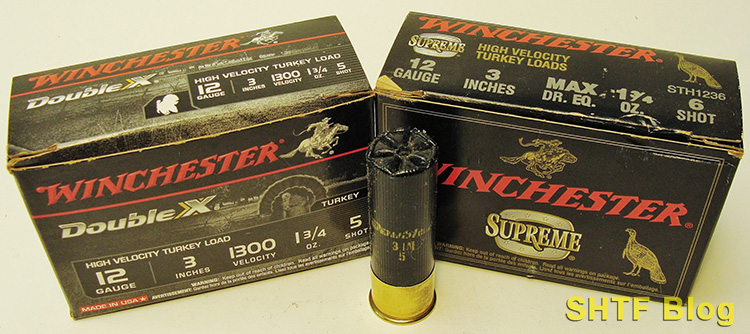
Dram-Equivalent vs Power
Many modern rifle cartridges develop over 50,000 P.S.I. at peak pressure. Shotguns run at much lower numbers – usually only 25%. With most pressures running below 12,000 P.S.I., we can still experience plenty of recoil when using warmer loads. Still, the bodies of shotgun shells (or cartridges) can be made from plastic (or even cardboard) instead of brass. Metal is confined to the base section. “High-base” types are used for stiffer field loads, and some that resemble brass are actually made from plated steel.
Black Powder Roots
The earliest “paper shells” used black powder, which was dispensed in drams. A fairly warm 12 gauge trap load contained 3 drams of black powder. More potent hunting loads might contain 4 drams. A light 12 Ga. load might only have 2 ¾ drams – or, even less.
Equivalent Smokeless Charges
Around 1900, modern smokeless powder caught on and we’ve been burning it ever since. However, the old-timers needed some frame of reference when matching power to game. That’s where “dram equivalent” comes from. But, it’s a volumetric measurement! That amount of modern smokeless powder would blow the gun to smithereens. Probably, the shooter as well!
3-Dram Example
A 12 gauge trap load is designed to break clay pigeons out to around 45 yards. A classic example is Winchester’s SUPER-HANDICAP HEAVY TARGET LOAD (upper left).The labeling indicates a 2 ¾” shell, containing 1 1/8 ounces of #7 ½ shot. Rumor has it this load uses a 3-dram equivalent charge – but the that information is missing. Muzzle velocity is shown instead; a zippy 1250 feet per second (fps). A possible reason; some trap clubs limit shells to 3-drams or less to limit shot-fall.
2 ¾-Dram Example
The 12 Ga. WINCHESTER LITE TARGET LOAD (lower left) is a tried an true skeet choice, great for crushing regulation targets at 21 yards. Its 2 ¾-dram charge will develop around 1145 fps with less recoil. Today’s 20 Gauge 2 ½-dram, 7/8 oz. target loads are nearly as effective, and recoil will also be less – in a gun of a similar weight.
Others
Heavier 2 ¾” 12 Ga. waterfowl loads might use 3 ¾ dram-equivalent charges to boost steel shot velocity.
A rule of thumb: Drams equate to velocity, whether generated by black or smokeless powder. Trouble is, sometimes the information can be cryptic. The box of low-recoil shells shown to the lower right is such an example.
Ounces
As noted above, a 12 Gauge bore will accept a dozen lead balls, each weighing 1 1/8 ounces. Not too coincidentally, that’s also the weight of a standard 2 ¾” target shot charge. Likewise, a standard 2 ¾” 20 Ga. contains 7/8 oz of shot. But, hunting loads often contain heavier payloads, and some 12 Ga. 3” Magnum versions can push two ounces. In a given shot size (see below), more weight equals extra pellets. Again though, the trade-off is greater recoil.
Hence, the WINCHESTER LOW RECOIL LOW NOISE TARGET LOAD (lower right). The “MIN” dram-equivalent powder charge is a mystery, but I’m guessing its less than a standard 20 Ga. The 26-Gram shot load works out to 0.92-ounce, and it exits at less than 1000 fps. This shell performs as advertised, and it’s a great choice for beginners, although it may not cycle all semi-autos.
Shotgun Shot Sizes
The American system uses numbers to quantify pellet-size. Like gauges, a lower number indicates a bigger pellet. A handy formula to determine actual birdshot diameter involves the number 17. Coincidentally, that’s the approximate size of a BB in hundreds of an inch; 0.177. If you subtract a pellets size from the number 17, you can determine its diameter in hundredths of an inch; its caliber.
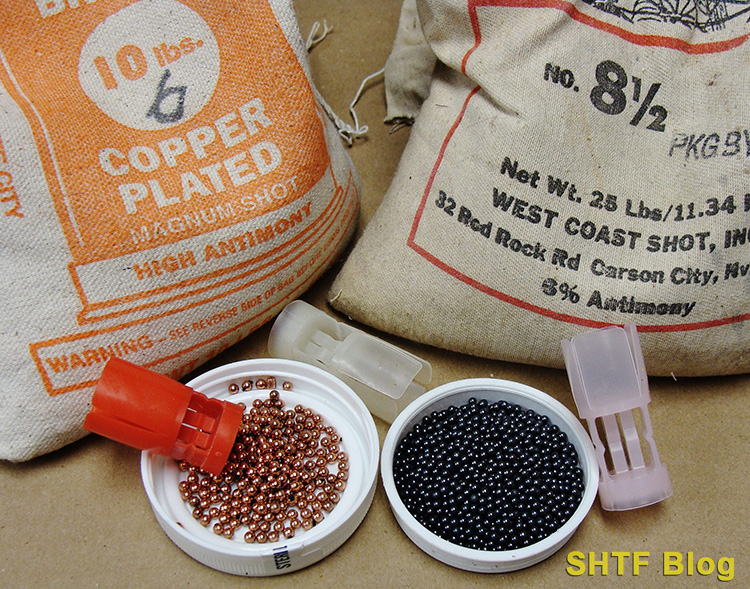
Conventional Pellets
A #2 pellet is just a bit smaller than a 17-caliber BB, measuring approximately 0.15”. It’s among the largest birdshot sizes and is typically used on geese. A #9 pellet, measuring around 0.08” is the smallest common size, used for short-range claybird games like skeet. Slightly larger #8, or #7 ½ pellets, are used for smaller upland birds and longer-range claybirds.
Pheasant hunters often prefer #6 shot, and plenty of them use #4s. Through the 1970s, these sizes would have worked for ducks. Then, Federal regulations banned lead shot for migratory waterfowl. Steel shot became the standard replacement, followed by alloys containing bismuth or tungsten. A magnet will tell you whether the shell contains steel shot, and your friendly game warden will probably have one.
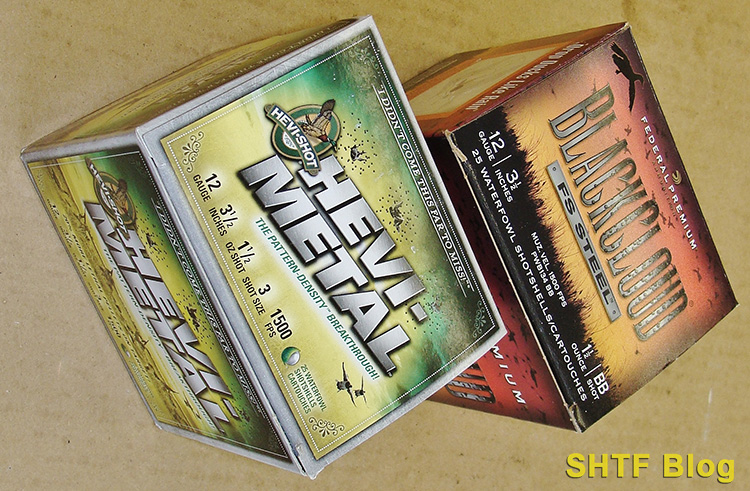
Shot Quality
Lead pellets are subject to violent forces during their transit through a barrel, resulting in deformation and inconsistent patterns. The solution is to harden the pellets by adding antimony. Because this alloy is expensive, premium shells cost more. Coating the pellets with copper or nickel plating can provide a further level of hardening, with a corresponding increase in price. Cheaper shells use softer shot pellets which throw larger, more irregular patterns. But, at close distances, wide patterns can often be an advantage.

Notable Cautions
Don’t attempt to fire a shell in a gun for which it is not designed! If you’re not sure about the gun, take it to a reputable gunsmith.
Chambers & Pressure
Firing a 3” shell in a 2 ¾” chamber will produce excessive pressure. Along the same idea, don’t fire standard 2 ¾” shells in a shorter 2 ½” chamber.
Older Shotguns
Compounding the problem, there are still plenty of old shotguns in circulation with Damascus barrels. Usually, they’ll be double-guns dating from 1900, or earlier. The steel (which may be iron) will probably display intriguing patterns that result during manufacturing. Metal bands are wrapped, hammered, and welded together around a mandrel, meaning the barrel walls are not homogenous.
Damascus barrels were developed to handle black powder, which runs at much lower pressure – and is also highly corrosive! Many develop weak spots that can rupture with disastrous results upon subjection to smokeless pressures. If you have a Damascus-barreled shotgun, treat it as a nice wall-hanger.
Gauge Mix-Ups
God forbid, you inadvertently drop a 20 gauge shell in a 12 gauge chamber. The smaller 20 will disappear and stop at its front end. A 12 Ga. shell loaded behind it can then be deadly. For those of us maintaining multiple gauges, this possibility is a real concern.
Bore Obstructions
Other obstructions may be less spectacular, but they’re still capable of inflicting serious injury. Some that come to mind include snow, mud, or a wad. If you experience a funny sounding report stop shooting, unload, and ensure nothing is lodged in the barrel.
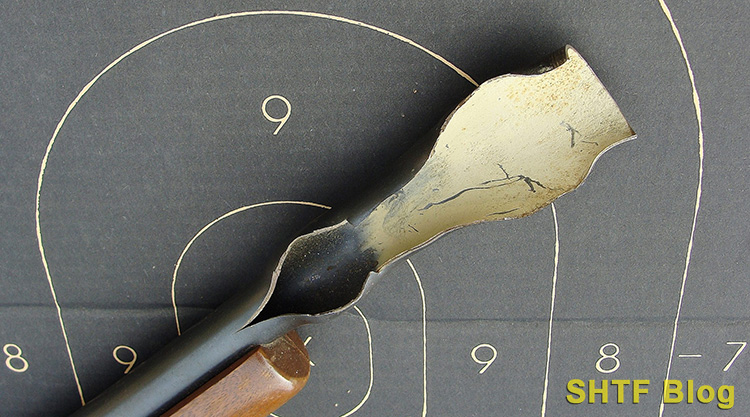
Last Thoughts
You’ve probably noted the absence of other shotgun projectiles such as large non-toxic pellets, buckshot, and slugs. The reason? There’s enough information there to fill another complete post.
Hopefully, this tome will serve as a guide for those in desperate need of shells, whether for weekend tailgate claybird shoots or upland bird hunts. No sense stocking up on poor choices if more suitable loads can be found. But, of course, that ain’t easy!

